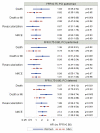Sex-related differences in fractional flow reserve-guided treatment
- PMID: 24149976
- PMCID: PMC3904351
- DOI: 10.1161/CIRCINTERVENTIONS.113.000762
Sex-related differences in fractional flow reserve-guided treatment
Abstract
Background: Sex-specific differences affect the evaluation, treatment, and prognosis of coronary artery disease. We tested the hypothesis that long-term outcomes of fractional flow reserve (FFR)-guided percutaneous coronary intervention (PCI) are different between women and men.
Methods and results: Consecutive 1090 patients, referred for PCI and undergoing FFR measurements at the Mayo Clinic between October 2002 and December 2009, were included in this registry study. Clinical events were compared between the sexes during a median follow-up of 50.9 months. Of all patients, women had higher FFR adjusted by visual coronary stenosis than men (P=0.03). The Kaplan-Meier percent of major adverse cardiac events at 5 years was 35% in women and 38% in men (P=0.54). Interestingly, in patients undergoing PCI with an FFR <0.75, the incidence of death or myocardial infarction was significantly higher in women than in men (hazard ratio, 2.16; 95% confidence interval, 1.04-4.51; P=0.04). Moreover, compared with patients with FFR >0.80, deferral of PCI for those with FFR between 0.75 and 0.80 was associated with an increased rate of major adverse cardiac events, particularly death or myocardial infarction in women (hazard ratio, 3.25; 95% confidence interval, 1.56-6.74; P=0.002) and revascularization in men (hazard ratio, 2.66; 95% confidence interval, 1.66-4.54; P<0.001).
Conclusions: Long-term outcome differs between women and men undergoing FFR-guided PCI. Our data suggest that the sex-based treatment strategy is necessary to further optimize prognosis of patients with coronary artery disease.
Keywords: fractional flow reserve, myocardial; percutaneous coronary intervention; sex.
Figures



Similar articles
-
Long-term outcomes of fractional flow reserve-guided vs. angiography-guided percutaneous coronary intervention in contemporary practice.Eur Heart J. 2013 May;34(18):1375-83. doi: 10.1093/eurheartj/eht005. Epub 2013 Jan 23. Eur Heart J. 2013. PMID: 23344979 Free PMC article.
-
Coronary Artery Bypass Grafting or Fractional Flow Reserve-Guided Percutaneous Coronary Intervention in Diabetic Patients With Multivessel Disease.Circ Cardiovasc Interv. 2020 Oct;13(10):e009157. doi: 10.1161/CIRCINTERVENTIONS.120.009157. Epub 2020 Oct 12. Circ Cardiovasc Interv. 2020. PMID: 33040579
-
Outcomes of percutaneous coronary intervention in intermediate coronary artery disease: fractional flow reserve-guided versus intravascular ultrasound-guided.JACC Cardiovasc Interv. 2010 Aug;3(8):812-7. doi: 10.1016/j.jcin.2010.04.016. JACC Cardiovasc Interv. 2010. PMID: 20723852
-
Fractional flow reserve versus angiography guided percutaneous coronary intervention: An updated systematic review.Catheter Cardiovasc Interv. 2018 Jul;92(1):18-27. doi: 10.1002/ccd.27302. Epub 2017 Oct 5. Catheter Cardiovasc Interv. 2018. PMID: 28980386
-
Should fraction flow reserve be considered an important decision-making tool to stratify patients with stable coronary artery disease for percutaneous coronary intervention?: A meta-analysis.Medicine (Baltimore). 2017 Nov;96(46):e8748. doi: 10.1097/MD.0000000000008748. Medicine (Baltimore). 2017. PMID: 29145326 Free PMC article. Review.
Cited by
-
Multimodality OCT, IVUS and FFR evaluation of coronary intermediate grade lesions in women vs. men.Front Cardiovasc Med. 2023 Jun 22;10:1021023. doi: 10.3389/fcvm.2023.1021023. eCollection 2023. Front Cardiovasc Med. 2023. PMID: 37424919 Free PMC article.
-
Fractional flow reserve: a clinical perspective.Int J Cardiovasc Imaging. 2017 Jul;33(7):961-974. doi: 10.1007/s10554-017-1159-2. Epub 2017 Jun 2. Int J Cardiovasc Imaging. 2017. PMID: 28577046 Free PMC article. Review.
-
Sex Differences in Long-Term Outcomes in Patients With Deferred Revascularization Following Fractional Flow Reserve Assessment: International Collaboration Registry of Comprehensive Physiologic Evaluation.J Am Heart Assoc. 2020 Feb 18;9(4):e014458. doi: 10.1161/JAHA.119.014458. Epub 2020 Feb 17. J Am Heart Assoc. 2020. PMID: 32063120 Free PMC article.
-
Unsettled Issues and Future Directions for Research on Cardiovascular Diseases in Women.Korean Circ J. 2018 Sep;48(9):792-812. doi: 10.4070/kcj.2018.0249. Korean Circ J. 2018. PMID: 30146804 Free PMC article. Review.
-
Fractional flow reserve-guided management in stable coronary disease and acute myocardial infarction: recent developments.Eur Heart J. 2015 Dec 1;36(45):3155-64. doi: 10.1093/eurheartj/ehv206. Epub 2015 Jun 2. Eur Heart J. 2015. PMID: 26038588 Free PMC article. Review.
References
-
- Shaw LJ, Bairey Merz CN, Pepine CJ, Reis SE, Bittner V, Kelsey SF, Olson M, Johnson BD, Mankad S, Sharaf BL, Rogers WJ, Wessel TR, Arant CB, Pohost GM, Lerman A, Quyyumi AA, Sopko G. Insights from the nhlbi-sponsored women's ischemia syndrome evaluation (wise) study: Part i: Gender differences in traditional and novel risk factors, symptom evaluation, and gender-optimized diagnostic strategies. J Am Coll Cardiol. 2006;47:S4–S20. - PubMed
-
- Leuzzi C, Modena MG. Coronary artery disease: Clinical presentation, diagnosis and prognosis in women. Nutr Metab Cardiovasc Dis. 2010;20:426–435. - PubMed
-
- Kelsey SF, James M, Holubkov AL, Holubkov R, Cowley MJ, Detre KM. Results of percutaneous transluminal coronary angioplasty in women. 1985-1986 national heart, lung, and blood institute's coronary angioplasty registry. Circulation. 1993;87:720–727. - PubMed
-
- Weintraub WS, Wenger NK, Kosinski AS, Douglas JS, Jr., Liberman HA, Morris DC, King SB., 3rd Percutaneous transluminal coronary angioplasty in women compared with men. J Am Coll Cardiol. 1994;24:81–90. - PubMed
Publication types
MeSH terms
Grants and funding
LinkOut - more resources
Full Text Sources
Other Literature Sources
Miscellaneous

